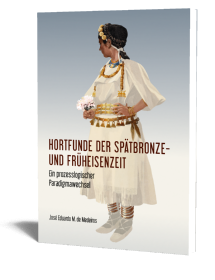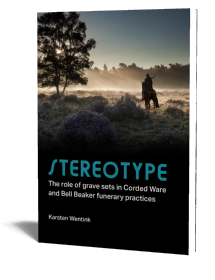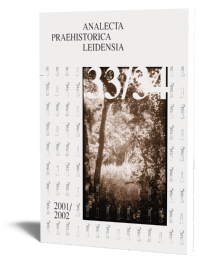A completely normal practice
The emergence of selective metalwork deposition in Denmark, north-west Germany, and the Netherlands between 2350-1500 BC
Marieke Visser | 2021

A completely normal practice
The emergence of selective metalwork deposition in Denmark, north-west Germany, and the Netherlands between 2350-1500 BC
Marieke Visser | 2021
Paperback ISBN: 9789464280159 | Hardback ISBN: 9789464280166 | Imprint: Sidestone Press Dissertations | Format: 182x257mm | 274 pp. | Language: English | 53 illus. (bw) | 35 illus. (fc) | Keywords: archaeology; prehistory; Bronze Age; Late Neolithic; North-West Europe; selective deposition; metalwork | download cover
Read online 441 times
- Digital & Online access
-
Buy via Sidestone (EU & UK)
-
Buy via our Distributors (WORLD)
For non-EU or UK destinations you can buy our books via our international distributors. Although prices may vary this will ensure speedy delivery and reduction in shipping costs or import tax. But you can also order with us directly via the module above.
UK international distributor
USA international distributor
-
Bookinfo
Paperback ISBN: 9789464280159 | Hardback ISBN: 9789464280166 | Imprint: Sidestone Press Dissertations | Format: 182x257mm | 274 pp. | Language: English | 53 illus. (bw) | 35 illus. (fc) | Keywords: archaeology; prehistory; Bronze Age; Late Neolithic; North-West Europe; selective deposition; metalwork | download cover
Read online 441 times

We will plant a tree for each order containing a paperback or hardback book via OneTreePlanted.org.
In Bronze Age Europe, an enormous amount of metalwork was buried in the ground and never retrieved. Patterns in the archaeological finds show that this was a deliberate practice: people systematically deposited valuable metal objects in specific places in the landscape, even in non-metalliferous regions. Although this practice seems strange and puzzling from our modern perspective, these patterns demonstrate that it was not simply a matter of irrational human behaviour. Instead, there were supra-regionally shared ideas and conventions behind this practice.
This book aims to acquire a better understanding of these ideas and conventions. By systematically investigating the objects and places that people selected for metalwork depositions, the logic behind the practice of selective metalwork deposition is unravelled. This research focuses specifically on the emergence of the practice in Denmark, northern Germany, and the Netherlands, a region without sources of copper and tin that has not been studied as a whole before, despite striking similarities in the archaeological record. Starting from the first introduction of metal to the research area, the emergence and development of selective metalwork depositions is examined and followed over time.
For thousands of years, deliberately depositing metal objects in the landscape was a completely normal thing to do. We are now beginning to catch a glimpse of the logic behind this human behaviour. This research does not only add a new chronological and geographical depth to the field of metalwork depositions, but it also provides a detailed catalogue of the metalwork from the research area.
PART I. INTRODUCTION AND METHODOLOGY
CHAPTER 1. Introduction
1.1 Introduction: the Torsted hoard
1.2 The Torsted hoard: not an isolated case
1.3 Conventional interpretation models of hoards
1.4 Ritual interpretations of Bronze Age depositions and the Scandinavian research tradition
1.5 The Scandinavian school of archaeology: emergence and characteristics
1.6 An economic approach to ritual depositions: ritual consumption of metalwork
1.7 Ritual interpretations: problems and challenges
1.8 Interpreting Bronze Age depositions: the European debate
1.9 Approach: patterns and practices
1.10 State of affairs
1.11 Aim and research questions
CHAPTER 2. Methodology and data
2.1 Introduction
2.2 Theoretical framework
2.3 Data selection and collection
2.4 Quality of the data
2.5 Database structure and variables
2.6 Network science
2.7 Research area
2.8 Chronology
2.9 Structure of the thesis
PART II. DATA AND PATTERNS
CHAPTER 3. Selective deposition before 2000 BC
3.1. Introduction
3.2. The introduction, disappearance, and reappearance of metal: a thousand-year gap?
3.3. Selective deposition in the Funnelbeaker Culture: an overview
3.4. Selective deposition in the Single Grave Culture: an overview
3.5. Patterns in selective deposition in the Bell Beaker period
3.6. Discussion
CHAPTER 4. Patterns in selective metalwork deposition in LN II
4.1. Introduction
4.2. Flint and metal daggers
4.3. Halberds
4.4. Axes and chisels
4.5. Ornaments
4.6. Unconventional hoards – unconventional events
4.7. Discussion
CHAPTER 5. Patterns in selective metalwork deposition in period IA
5.1 Introduction
5.2 Flint and metal daggers
5.3 Axes and chisels
5.4 Spearheads
5.5 Ornaments
5.6 Ösenringe
5.7 Hoards: unconventional events
5.8 Discussion
CHAPTER 6. Patterns in selective metalwork deposition in period IB
6.1 Introduction
6.2 Flint and metal daggers and swords
6.3 Axes and chisels
6.4 Spearheads
6.5 Ornaments
6.6 Hoards and burials
6.7 Discussion
PART III. CONCLUSION
CHAPTER 7. A completely normal practice: selective metalwork deposition through the ages
7.1 ‘Deviating beginnings’
7.2 The gap?
7.3 The reinvention
7.4 The big rise
7.5 Prelude to the finale
7.6 The grand finale: the Nordic Bronze Age and Sögel-Wohlde period
7.7 Epilogue
CHAPTER 8. The selection of objects: cultural biographies
8.1 Objects: developments over time
8.2 Foreign vs. local styles
8.3 Persistent vs. new objects
8.3.2 New objects
8.4 The use lives of objects
8.5 Conclusion
CHAPTER 9. Burying things with the dead: creating an image
9.1 Barrows and metalwork: social inequality?
9.2 Creating an image of the dead: a case study
9.3 Burial gifts and conventions: an overview
9.4 LN II: from burials to wetlands…
9.5 Period IA: …and back again to burials
9.6 Period IB: warrior burials and regional practices
9.7 Conclusion
CHAPTER 10. ‘Non-burial-gifts’: placing things in the landscape
10.1 The selection of landscape settings: an overview
10.2 Hoards vs. single object deposits
10.3 Hoards in LN II: international contacts and the community
10.4 Hoards in period IA: regional practices and the community
10.5 Hoards in period IB: shared ideas and regional interpretations
10.6 Conclusion
Epilogue: a completely normal practice
References
Nederlandse samenvatting (Dutch summary)
Acknowledgements

Dr. Marieke Visser
Marieke Visser studied Scandinavian Languages and Cultures at Amsterdam University, specialising in rune inscriptions in Sweden, and Archaeology at Stockholm University, where she specialised in the Prehistory of Northern Europe and Osteoarchaeology. In 2015, she started her PhD at Leiden University within the framework of the NWO-funded project Economies of Destruction, the results of which are presented in this book.
Abstract:
In Bronze Age Europe, an enormous amount of metalwork was buried in the ground and never retrieved. Patterns in the archaeological finds show that this was a deliberate practice: people systematically deposited valuable metal objects in specific places in the landscape, even in non-metalliferous regions. Although this practice seems strange and puzzling from our modern perspective, these patterns demonstrate that it was not simply a matter of irrational human behaviour. Instead, there were supra-regionally shared ideas and conventions behind this practice.
This book aims to acquire a better understanding of these ideas and conventions. By systematically investigating the objects and places that people selected for metalwork depositions, the logic behind the practice of selective metalwork deposition is unravelled. This research focuses specifically on the emergence of the practice in Denmark, northern Germany, and the Netherlands, a region without sources of copper and tin that has not been studied as a whole before, despite striking similarities in the archaeological record. Starting from the first introduction of metal to the research area, the emergence and development of selective metalwork depositions is examined and followed over time.
For thousands of years, deliberately depositing metal objects in the landscape was a completely normal thing to do. We are now beginning to catch a glimpse of the logic behind this human behaviour. This research does not only add a new chronological and geographical depth to the field of metalwork depositions, but it also provides a detailed catalogue of the metalwork from the research area.
Contents
PART I. INTRODUCTION AND METHODOLOGY
CHAPTER 1. Introduction
1.1 Introduction: the Torsted hoard
1.2 The Torsted hoard: not an isolated case
1.3 Conventional interpretation models of hoards
1.4 Ritual interpretations of Bronze Age depositions and the Scandinavian research tradition
1.5 The Scandinavian school of archaeology: emergence and characteristics
1.6 An economic approach to ritual depositions: ritual consumption of metalwork
1.7 Ritual interpretations: problems and challenges
1.8 Interpreting Bronze Age depositions: the European debate
1.9 Approach: patterns and practices
1.10 State of affairs
1.11 Aim and research questions
CHAPTER 2. Methodology and data
2.1 Introduction
2.2 Theoretical framework
2.3 Data selection and collection
2.4 Quality of the data
2.5 Database structure and variables
2.6 Network science
2.7 Research area
2.8 Chronology
2.9 Structure of the thesis
PART II. DATA AND PATTERNS
CHAPTER 3. Selective deposition before 2000 BC
3.1. Introduction
3.2. The introduction, disappearance, and reappearance of metal: a thousand-year gap?
3.3. Selective deposition in the Funnelbeaker Culture: an overview
3.4. Selective deposition in the Single Grave Culture: an overview
3.5. Patterns in selective deposition in the Bell Beaker period
3.6. Discussion
CHAPTER 4. Patterns in selective metalwork deposition in LN II
4.1. Introduction
4.2. Flint and metal daggers
4.3. Halberds
4.4. Axes and chisels
4.5. Ornaments
4.6. Unconventional hoards – unconventional events
4.7. Discussion
CHAPTER 5. Patterns in selective metalwork deposition in period IA
5.1 Introduction
5.2 Flint and metal daggers
5.3 Axes and chisels
5.4 Spearheads
5.5 Ornaments
5.6 Ösenringe
5.7 Hoards: unconventional events
5.8 Discussion
CHAPTER 6. Patterns in selective metalwork deposition in period IB
6.1 Introduction
6.2 Flint and metal daggers and swords
6.3 Axes and chisels
6.4 Spearheads
6.5 Ornaments
6.6 Hoards and burials
6.7 Discussion
PART III. CONCLUSION
CHAPTER 7. A completely normal practice: selective metalwork deposition through the ages
7.1 ‘Deviating beginnings’
7.2 The gap?
7.3 The reinvention
7.4 The big rise
7.5 Prelude to the finale
7.6 The grand finale: the Nordic Bronze Age and Sögel-Wohlde period
7.7 Epilogue
CHAPTER 8. The selection of objects: cultural biographies
8.1 Objects: developments over time
8.2 Foreign vs. local styles
8.3 Persistent vs. new objects
8.3.2 New objects
8.4 The use lives of objects
8.5 Conclusion
CHAPTER 9. Burying things with the dead: creating an image
9.1 Barrows and metalwork: social inequality?
9.2 Creating an image of the dead: a case study
9.3 Burial gifts and conventions: an overview
9.4 LN II: from burials to wetlands…
9.5 Period IA: …and back again to burials
9.6 Period IB: warrior burials and regional practices
9.7 Conclusion
CHAPTER 10. ‘Non-burial-gifts’: placing things in the landscape
10.1 The selection of landscape settings: an overview
10.2 Hoards vs. single object deposits
10.3 Hoards in LN II: international contacts and the community
10.4 Hoards in period IA: regional practices and the community
10.5 Hoards in period IB: shared ideas and regional interpretations
10.6 Conclusion
Epilogue: a completely normal practice
References
Nederlandse samenvatting (Dutch summary)
Acknowledgements

Dr. Marieke Visser
Marieke Visser studied Scandinavian Languages and Cultures at Amsterdam University, specialising in rune inscriptions in Sweden, and Archaeology at Stockholm University, where she specialised in the Prehistory of Northern Europe and Osteoarchaeology. In 2015, she started her PhD at Leiden University within the framework of the NWO-funded project Economies of Destruction, the results of which are presented in this book.
- Digital & Online access
-
Buy via Sidestone (EU & UK)
-
Buy via our Distributors (WORLD)
For non-EU or UK destinations you can buy our books via our international distributors. Although prices may vary this will ensure speedy delivery and reduction in shipping costs or import tax. But you can also order with us directly via the module above.
UK international distributor
USA international distributor
- Browse all books by subject
-
Search all books

We will plant a tree for each order containing a paperback or hardback book via OneTreePlanted.org.
You might also like:
© 2025 Sidestone Press KvK nr. 28114891 Privacy policy Sidestone Newsletter Terms and Conditions (Dutch)








